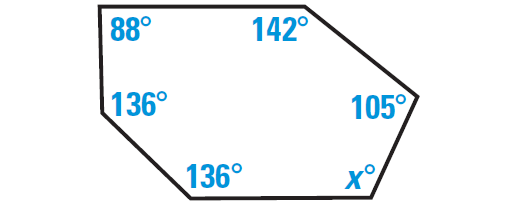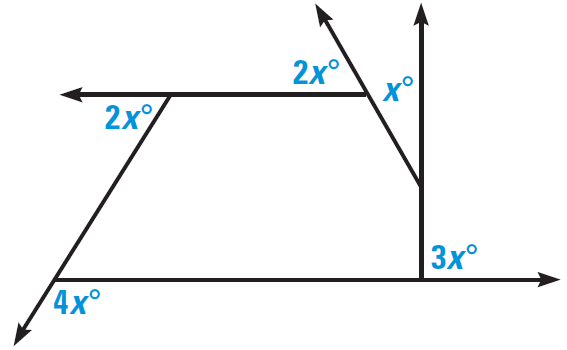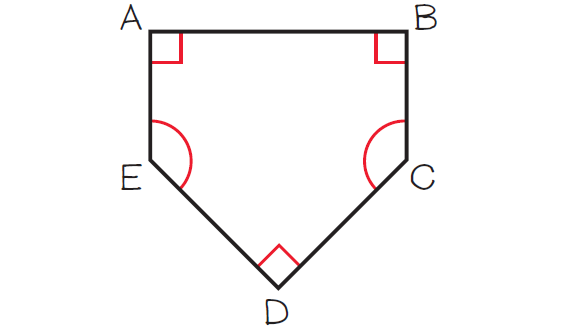ANGLE MEASURES IN POLYGONS WORKSHEET
Subscribe to our ▶️ YouTube channel 🔴 for the latest videos, updates, and tips.
Problem 1 :
Find the value of x in the diagram shown below.

Problem 2 :
The measure of each interior angle of a regular polygon is 140°. How many sides does the polygon have ?
Problem 3 :
Find the value of x in the regular polygon shown below.

Problem 4 :
Find the value of x in the diagram shown below.

Problem 5 :
A home plate maker for a soft ball field is a pentagon. Three of the interior angles of the pentagon are right angles. The remaining two interior angles are congruent. What is the measure of each angle ?
Problem 6 :
If we were designing the home plate marker for some new type of ball game, would it be possible to make a home plate marker that is a regular polygon with each interior angle having a measure of (a) 135° ? (b) 145° ?

Answers
1. Answer :

The polygon shown in the diagram above has 6 sides. So it is hexagon.
The sum of the measures of the interior angles of any hexagon is
= (6 - 2) ⋅ 180°
= 4 ⋅ 180°
= 720°
We can add the measures of all interior angles of the above hexagon and the sum can be equated to 720°.
So, we have
136° + 136° + 88° + 142° + 105° + x° = 720°
Simplify.
607 + x = 720
Subtract 607 from each side.
x = 113
Hence, the measure of sixth interior angle of the hexagon is 113°.
2. Answer :
By Polygon Interior Angles Theorem, we have
[(n - 2) ⋅ 180°]/n = 140°
Multiply each side by n.
(n - 2) ⋅ 180 = 140n
Simplify.
180n - 360 = 140n
Subtract 140n from each side.
40n - 360 = 0
Add 360 to each side.
40n = 360
Divide each side by 40.
40n/40 = 360/40
n = 9
Hence, the polygon has 9 sides and it is a regular nonagon.
3. Answer :

The polygon shown above is regular and it has 7 sides. So, it is a regular heptagon and the measure of each exterior angle is x°.
By the Polygon Exterior Angles Theorem, we have
x° = 1/7 ⋅ 360°
Simplify.
x ≈ 51.4
Hence, the measure of each exterior angle of a regular heptagon is about 51.4°.
4. Answer :

The polygon shown in the diagram above has 5 sides. So it is pentagon.
The sum of the measures of the exterior angles of a convex polygon, one angle at each vertex is
= 360°
We can add the measures of all exterior angles of the above pentagon and the sum can be equated to 360°.
So, we have
2x° + x° + 3x° + 4x° + 2x° = 360°
Simplify.
12x = 360
Divide each side by 12.
12x/12 = 360/12
x = 30
5. Answer :
Draw a Sketch :
Sketch and label a diagram for the above plate maker. It is a non regular pentagon.
Let ∠A, ∠B and ∠D be the right angles.
Let ∠C and ∠E be the remaining two congruent angles.
So, we have
∠C ≅ ∠E

The sum of the measures of the interior angles of a pentagon is
= (5 - 2) ⋅ 180°
= 3 ⋅ 180°
= 540°
Verbal Model :

Labels :
Sum of measures of interior angles = 540°
Measure of each right angle = 90°
Measure of ∠C and ∠E = x°
Reasoning :
Write the equation.
540° = 3 ⋅ 90° + 2x°
Simplify.
540 = 270 + 2x
Subtract 270 from each side.
270 = 2x
Divide each side by 2.
270/2 = 2x/2
135 = x
Hence, the measure of each of the two congruent angles is 135°.
6. Answer :
Solution (a) :
Let n be the number of sides of the regular polygon.
By Polygon Interior Angles Theorem, we have
[(n - 2) ⋅ 180°] / n = 135°
Multiply each side by n.
(n - 2) ⋅ 180 = 135n
180n - 360 = 135n
Subtract 135n from each side.
45n - 360 = 0
Add 360 to each side.
45n = 360
Divide each side by 45.
45n/45 = 360/45
n = 8
Yes, it would be possible. Because a polygon can have 8 sides.
Solution (b) :
Let n be the number of sides of the regular polygon.
By Polygon Interior Angles Theorem, we have
[(n - 2) ⋅ 180°] / n = 145°
Multiply each side by n.
(n - 2) ⋅ 180 = 145n
180n - 360 = 145n
Subtract 145n from each side.
35n - 360 = 0
Add 360 to each side.
35n = 360
Divide each side by 35.
35n/35 = 360/35
n ≈ 10.3
No, it would not be possible. Because, a polygon can not have 10.3 sides.
Subscribe to our ▶️ YouTube channel 🔴 for the latest videos, updates, and tips.
Kindly mail your feedback to v4formath@gmail.com
We always appreciate your feedback.
About Us | Contact Us | Privacy Policy
©All rights reserved. onlinemath4all.com
Recent Articles
-
10 Hard SAT Math Questions (Part - 40)
Dec 23, 25 06:12 AM
10 Hard SAT Math Questions (Part - 40) -
AP Calculus BC Problems with Solutions
Dec 20, 25 10:51 AM
AP Calculus BC Problems with Solutions -
AP Precalculus Problems and Solutions (Part - 1)
Dec 20, 25 10:49 AM
AP Precalculus Problems and Solutions (Part - 1)
